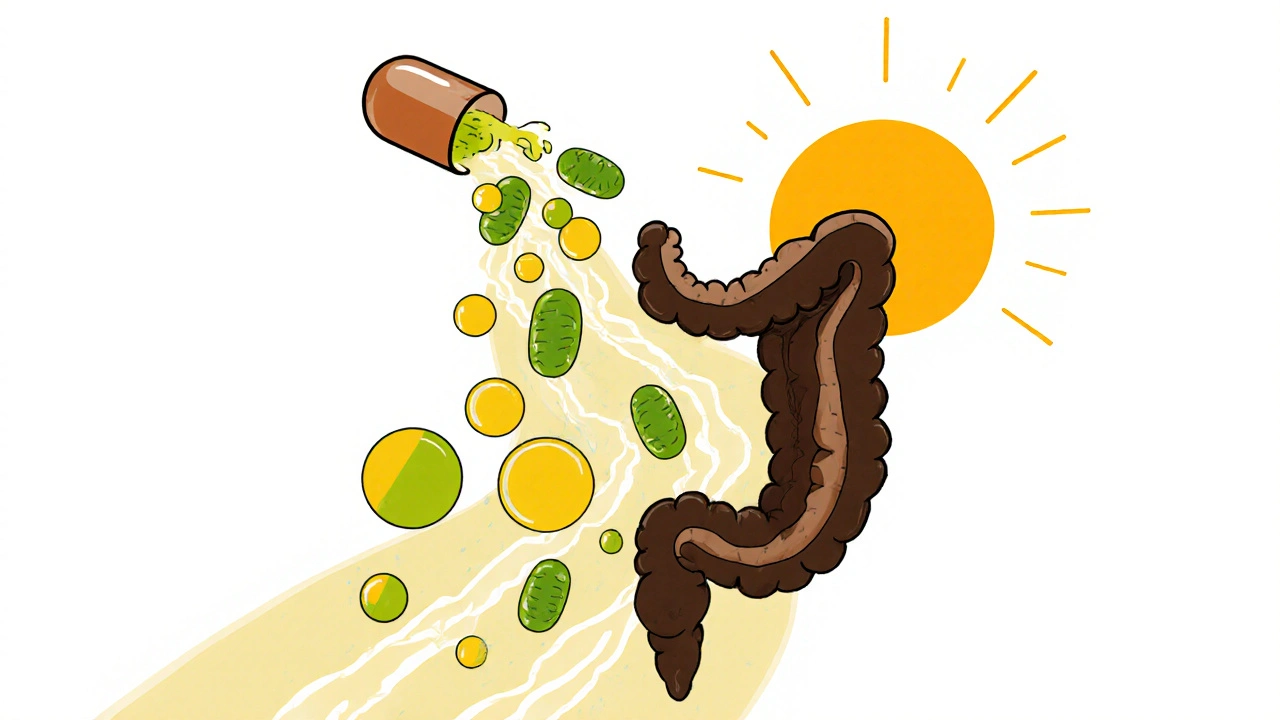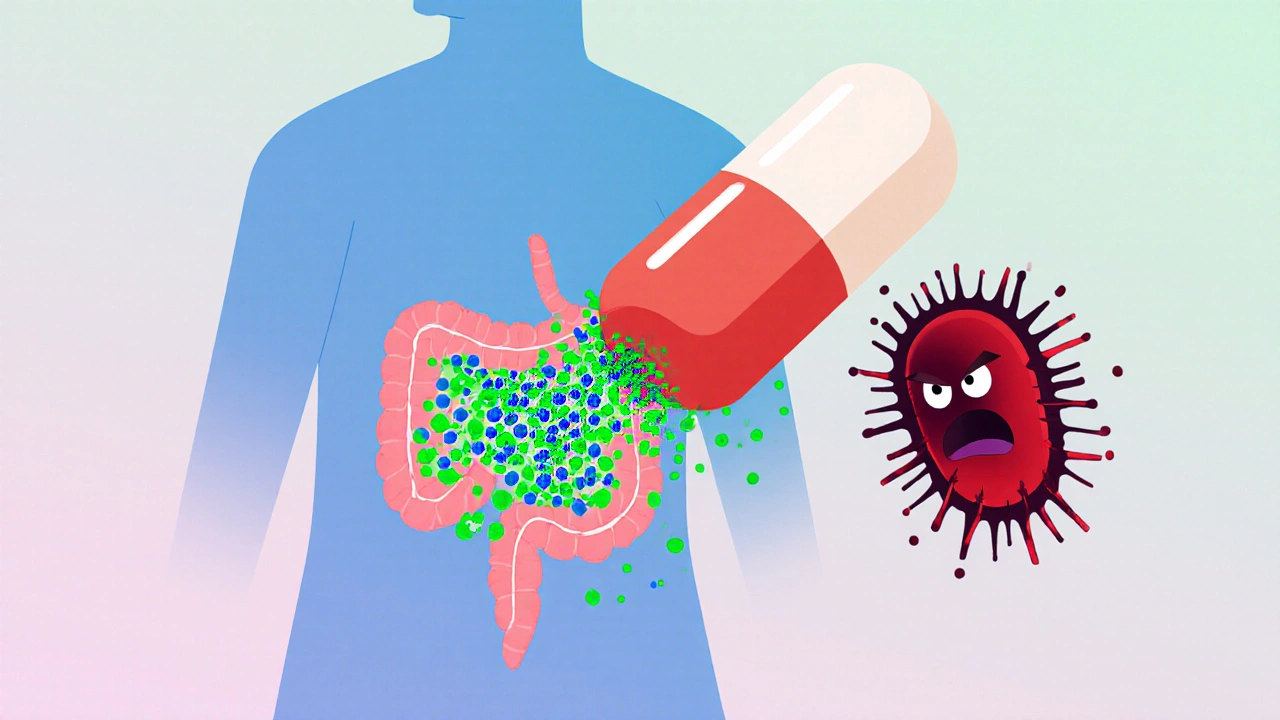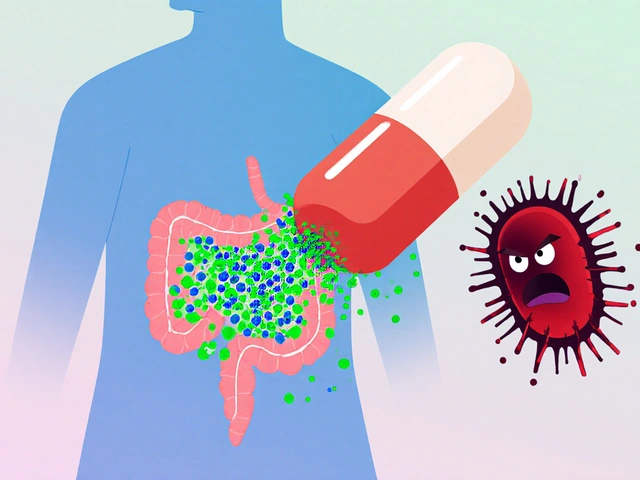C. diff colitis isn’t just a nasty stomach bug-it’s a dangerous ripple effect caused by something most people think is harmless: antibiotics. Every year in the U.S., about half a million people get infected with Clostridioides difficile, and nearly 30,000 die from it. Many of these cases aren’t from dirty hospitals or bad food-they’re from a prescription meant to help. When antibiotics wipe out the good bacteria in your gut, C. diff takes over, unleashing toxins that turn your colon into a battleground of inflammation, severe diarrhea, and sometimes, life-threatening complications.
Why Antibiotics Are the Main Culprit
It’s not just any antibiotic. Some are far more likely to trigger C. diff colitis than others. Research tracking over 33,000 hospital stays found that certain drugs nearly double your risk. Piperacillin-tazobactam, a common IV antibiotic used for serious infections, carries the highest risk-2.18 times more likely to cause C. diff than other antibiotics. Carbapenems and later-generation cephalosporins like ceftriaxone are just as dangerous. Even more surprising? Clindamycin, a cheap, widely prescribed oral antibiotic for acne or dental infections, is one of the worst offenders. A 2023 NIH analysis showed it’s linked to more cases than nearly any other drug.On the flip side, tetracyclines like doxycycline are much safer. They don’t wreck your gut flora as badly. But here’s the catch: doctors don’t always know which antibiotic will cause problems until it’s too late. That’s because C. diff doesn’t strike immediately. The risk creeps up. Each extra day on antibiotics increases your chance by 8%. And after 14 days, the danger spikes again-like a second wave hitting after you thought the storm had passed.
What makes this worse is that most people don’t realize they’re at risk until they’re already sick. A 2024 study found that nearly half of community cases happened in people who’d taken antibiotics within the past 30 days. That means your infection could be traced back to a sinus pill you took last month, not something you got in the hospital.
The Hidden Risk: Asymptomatic Carriers
Not everyone who has C. diff in their gut gets sick. About 5% of healthy adults carry the bacteria without symptoms. These are called asymptomatic carriers. For them, antibiotics don’t increase their risk of getting sick-they already have the bug. But here’s the scary part: they can still spread it. And if they go into a hospital or nursing home, they can infect others who are on antibiotics. That’s why hospitals screen high-risk patients, even if they’re not showing symptoms.For people who aren’t carriers, the solution is simple: don’t take antibiotics unless you really need them. But for carriers, it’s trickier. Stopping antibiotics won’t help them-they already have the bacteria. That’s why experts are now looking at other tools: probiotics, monoclonal antibodies, and even new microbiome therapies. But right now, the best defense is still smart antibiotic use. The CDC’s Start Smart-Then Focus program pushes doctors to review prescriptions within 48 to 72 hours. If the infection isn’t bacterial, stop the drug. If it is, use the narrowest-spectrum option possible.

When Standard Treatment Fails: Recurrent Infections
Most C. diff cases are treated with vancomycin or fidaxomicin. Vancomycin works, but it’s not perfect. About 20% of people get it again after treatment. For some, it comes back once. For others, it’s a cycle: treatment, relief, relapse, repeat. This is called recurrent C. diff colitis. One patient in Houston described it this way: “I went through three rounds of vancomycin. Each time, I felt fine for a few weeks. Then the cramps came back. I lost 20 pounds. I stopped going out. I was terrified.”Why does this happen? Because antibiotics kill the bad bacteria-but they don’t rebuild the good ones. Your gut microbiome stays broken. Without a healthy balance of microbes, C. diff has an open door to return. That’s where the real breakthrough comes in.
Fecal Transplant: The Unexpected Cure
Fecal microbiota transplantation (FMT) sounds extreme-but it’s one of the most effective treatments in modern medicine. The idea is simple: take healthy stool from a screened donor, process it, and put it into the patient’s colon. It’s not about “poop.” It’s about restoring the microbial ecosystem that antibiotics destroyed.The evidence is overwhelming. A landmark 2013 study in the New England Journal of Medicine found that 94% of patients with recurrent C. diff were cured after one or two FMT treatments. Compare that to vancomycin, which only worked in 31% of cases. Since then, multiple reviews have confirmed success rates between 85% and 90%. The American Gastroenterological Association now recommends FMT for anyone who’s had three or more recurrences.
How is it done? Most often, it’s delivered via colonoscopy-about 65% of cases. Some use enemas. But the most convenient method now is oral capsules. FDA-approved products like Rebyota and Vowst are frozen, processed stool in pill form. You swallow them at home. No colonoscopy. No mess. Just a simple course of pills that rebuild your gut from the inside out.
Cost-wise, FMT runs $1,500 to $3,000. That’s a fraction of the $11,000 average cost of a single hospitalization for recurrent C. diff. And unlike repeated rounds of antibiotics, FMT doesn’t risk creating drug-resistant superbugs.

What About Probiotics?
You’ve probably heard about yogurt, kefir, or probiotic supplements for gut health. But when it comes to C. diff, the evidence doesn’t back them up. The Infectious Diseases Society of America says there’s no strong proof that probiotics prevent or treat recurrent C. diff. Worse-some studies show they can cause serious infections in people with weakened immune systems, including bloodstream infections from the very bacteria they’re meant to help.One small study looked at patients who stopped antibiotics and took kefir daily. They saw results similar to FMT. But that’s one small group. It’s not enough to change guidelines. For now, probiotics are not a substitute for proven treatments.
What’s Next? The Future of Gut Healing
The FDA’s approval of Rebyota and Vowst in 2022 and 2023 marked a turning point. FMT is no longer a last-resort, doctor-compounded procedure. It’s becoming a regulated medicine. And the next wave is even more targeted. SER-109, an oral microbiome therapy made from purified bacterial spores, showed 88% success in late-stage trials. It’s designed to replace only the missing good bacteria-not dump in everything from a donor’s stool. That means fewer side effects, more consistency, and easier access.Meanwhile, researchers are working on monoclonal antibodies like bezlotoxumab, which blocks the toxin that damages the colon. Used alongside antibiotics, it cuts recurrence rates by 10%. It’s expensive-around $3,700 per dose-but for high-risk patients, it’s a game-changer.
The CDC now calls C. diff an “urgent threat.” That’s the highest risk category. And they’re pushing hard for antibiotic stewardship in every clinic, hospital, and nursing home. The goal? Reduce unnecessary prescriptions. Shorten treatment durations. Avoid the broadest-spectrum drugs unless absolutely needed.
For patients, the message is clear: don’t take antibiotics unless you need them. If you’ve had C. diff before and it came back, talk to your doctor about FMT. It’s not experimental. It’s not fringe. It’s the most reliable cure we have for recurring infections.
Can you get C. diff from antibiotics you took months ago?
Yes. Antibiotics can disrupt your gut bacteria for weeks or even months. Many people who develop community-associated C. diff had taken antibiotics within the past 30 days. Even if you finished the course, the damage to your microbiome can linger, letting C. diff grow back later.
Is fecal transplant safe?
When done through FDA-approved products like Rebyota or Vowst, FMT is very safe. Donors are rigorously screened for infections, including HIV, hepatitis, and antibiotic-resistant bacteria. The biggest risk is mild bloating or cramping after the procedure. Serious side effects are rare. Long-term risks, like changes in metabolism or immunity, are still being studied, but no major issues have been found in over a decade of use.
Why not just use stronger antibiotics?
Stronger antibiotics make the problem worse. They kill even more good bacteria, leaving C. diff with even less competition. That’s why recurrent cases often get worse with each round of antibiotics. FMT doesn’t kill bacteria-it rebuilds the balance. It’s like reseeding a lawn after a chemical spill, not spraying more poison.
Can you prevent C. diff without antibiotics?
Yes. The best prevention is avoiding unnecessary antibiotics. Wash your hands with soap and water (alcohol gels don’t kill C. diff spores). If you’re in a hospital, ask if antibiotics are truly needed. If you’ve had C. diff before, avoid broad-spectrum drugs like clindamycin or ceftriaxone unless there’s no alternative.
How long does it take to recover after a fecal transplant?
Most people feel better within days. Diarrhea stops, cramps fade, and energy returns. Full microbiome recovery takes weeks to months, but symptoms usually resolve quickly. Follow-up tests aren’t always needed unless symptoms return. The goal isn’t to eliminate every C. diff spore-it’s to restore enough good bacteria to keep it in check.



Emily Craig
November 25, 2025 AT 04:19So antibiotics are basically the silent killers we all carry around like they're candy? I took amoxicillin for a sinus thing last winter and thought I was fine-turns out I was just a walking C. diff incubator. This post blew my mind. I'm never taking another pill without asking if it's really necessary.
Arup Kuri
November 25, 2025 AT 12:57They don't want you to know this but Big Pharma profits off recurrent C. diff. They sell you the antibiotic then sell you the next one then the next. FMT? Too cheap. Too natural. No patent. No profit. The FDA approves these pill versions just to make it look like they're doing something. It's all smoke and mirrors. Wake up people.
Jennifer Griffith
November 26, 2025 AT 20:55Wait so poop in a pill?? Like actual poop?? I'm not taking that even if it works. My grandma would roll in her grave. Also why are we even talking about this like it's normal??
Timothy Sadleir
November 27, 2025 AT 04:07It is a profound epistemological rupture in modern medical paradigms that we have come to rely upon the ingestion of conspecific fecal matter to restore physiological homeostasis. The irony is not lost upon me that our most effective intervention against a pathogen we ourselves induced lies in the very substance we have been conditioned to revile. This is not medicine. This is metaphysics with a colonoscope.
Kimberley Chronicle
November 27, 2025 AT 23:14From a microbiome engineering standpoint, SER-109 represents a significant leap toward precision microbiota restoration. Unlike broad-spectrum FMT, it targets keystone taxa like Clostridium scindens and Faecalibacterium prausnitzii, which are critical for secondary bile acid metabolism and C. diff inhibition. The spore-forming delivery system ensures colonic engraftment without pathogenic contamination risk. This is the future-targeted, scalable, and clinically validated.
Srikanth BH
November 29, 2025 AT 02:00Hey I know this sounds wild but I had three recurrences and tried FMT via capsules. Within 48 hours I felt like myself again. No more panic attacks every time I needed to pee. I’m not saying it’s magic but it gave me my life back. If you’re stuck in that loop-you’ve got nothing to lose. Talk to your doc. Seriously.
Sharley Agarwal
November 30, 2025 AT 02:44People take antibiotics like water. No wonder we’re all sick. You want to fix your gut? Stop being lazy. Stop taking pills for every sniffle. Your body isn’t broken. You’re just weak.
Elise Lakey
November 30, 2025 AT 05:35I’ve been researching this since my mom had a recurrence last year. I’m curious-how do they screen donors for something like this? Is there any long-term data on whether recipients develop new allergies or autoimmune issues after FMT? I’m not against it, I just want to understand the full picture before considering it.
Roscoe Howard
December 1, 2025 AT 20:16Let us not forget that this nation’s healthcare system has been infiltrated by foreign regulatory influences. The FDA’s approval of fecal-based therapies was not based on rigorous American science-it was influenced by European experimental protocols and funded by multinational biotech consortia. We must demand homegrown solutions, not imported biological chaos. Our microbiomes are sacred. Let us protect them from globalist medical experiments.